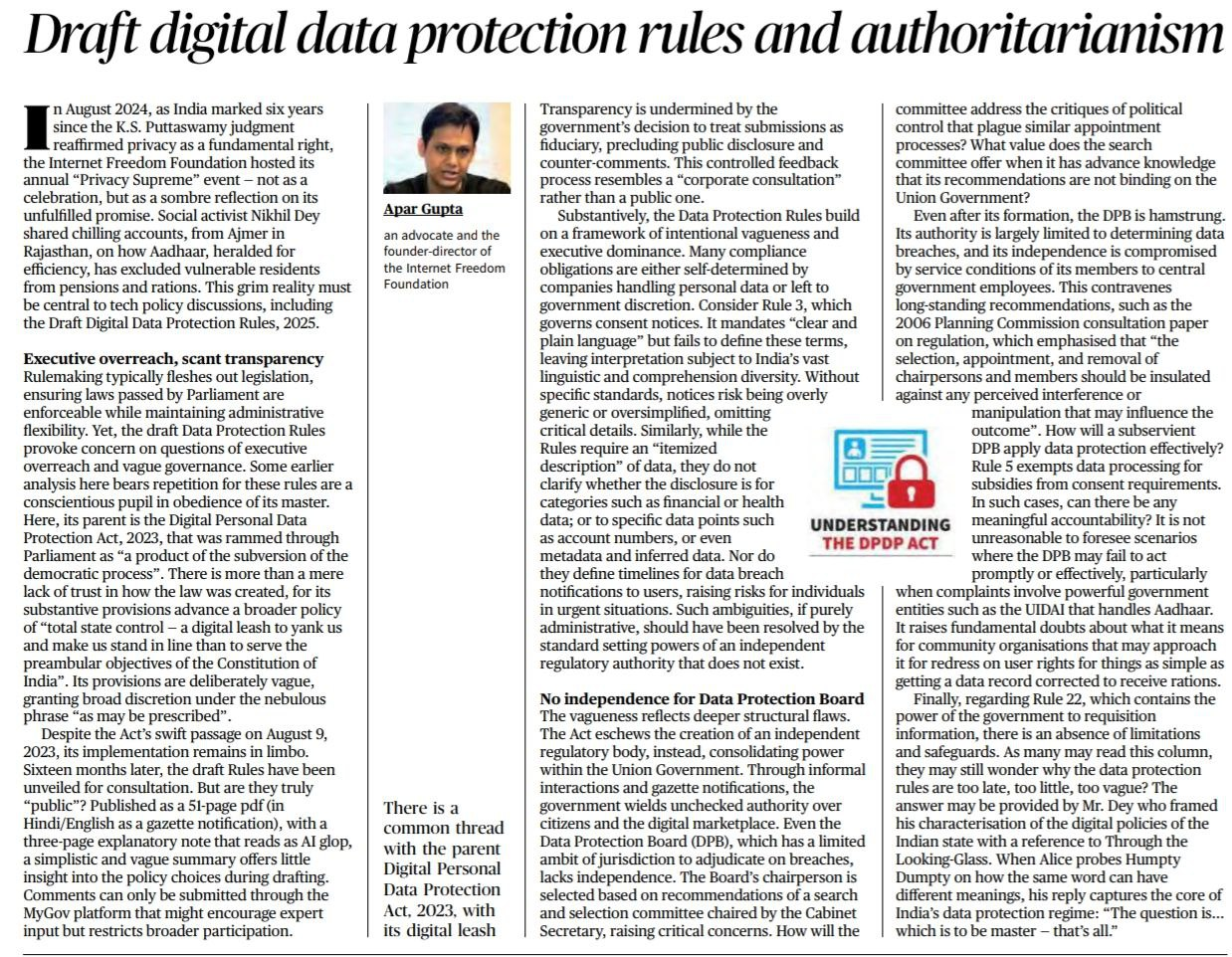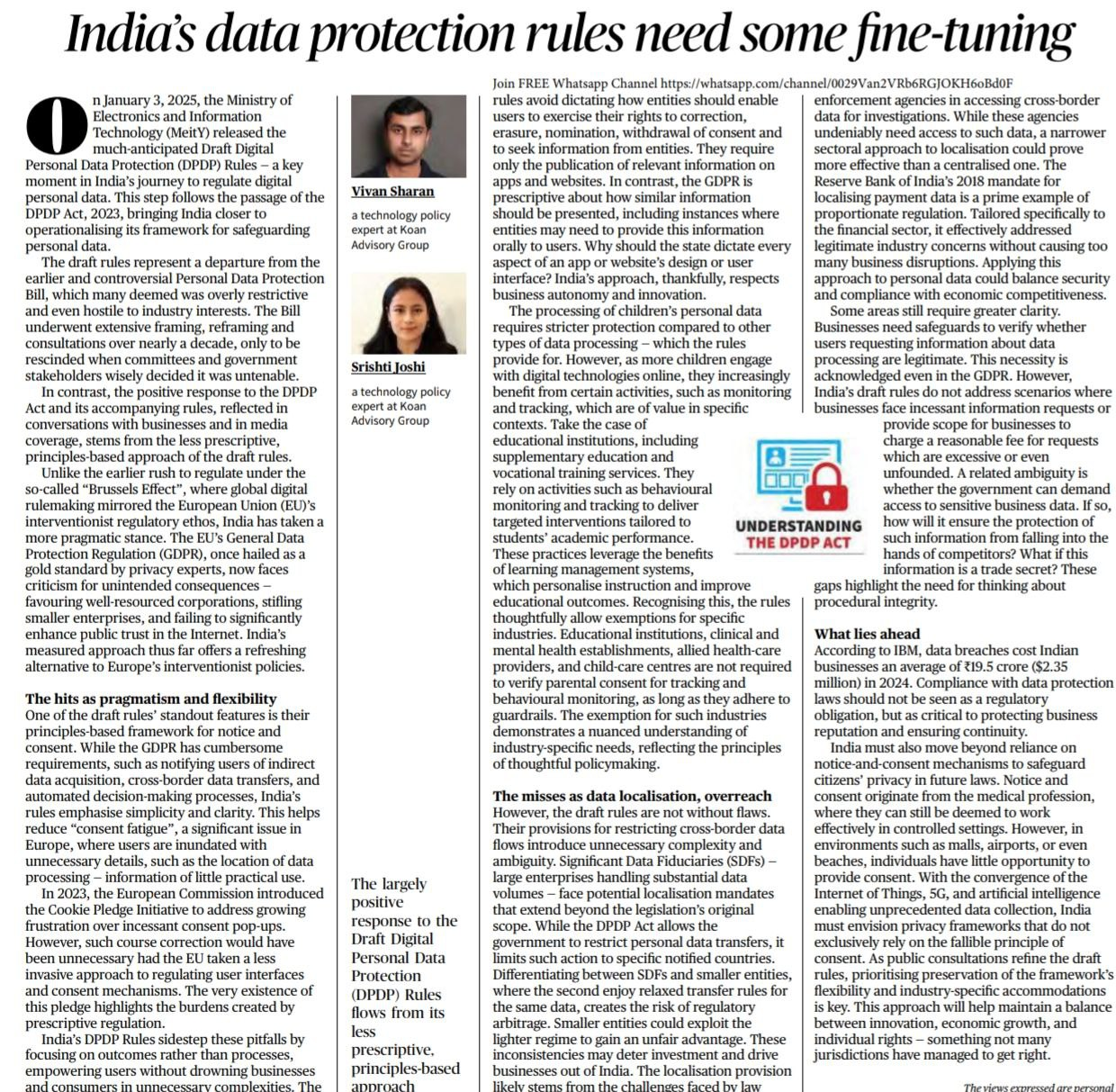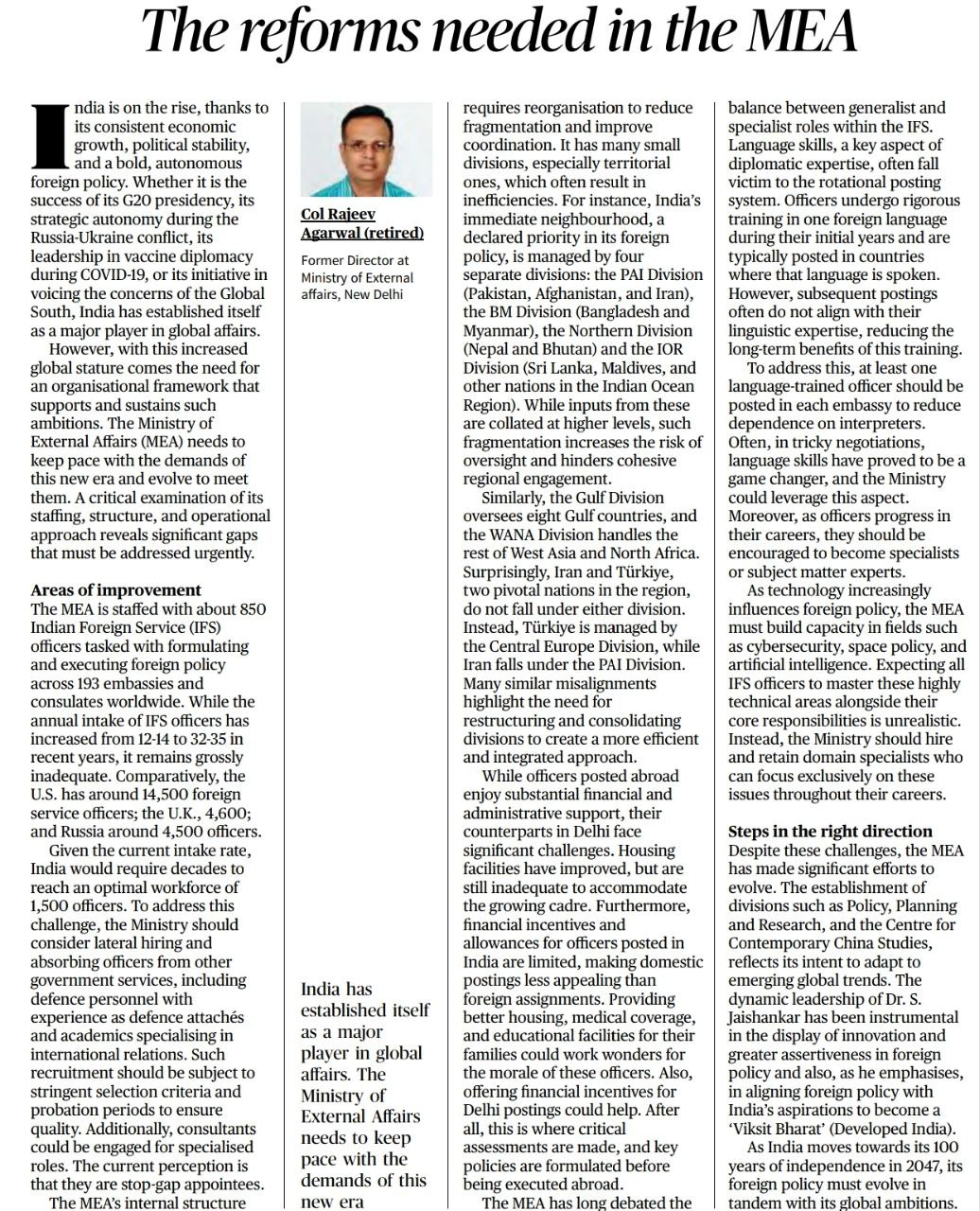1. Draft Digital Personal Data Protection Rules: Concerns of Authoritarianism and Executive Overreach
Introduction
- In 2024, the Internet Freedom Foundation highlighted the unfulfilled promise of privacy as a fundamental right despite the landmark K.S. Puttaswamy judgment (2017).
- The Draft Digital Personal Data Protection (DDPP) Rules, 2025, have raised concerns regarding executive overreach, lack of transparency, and inadequate protection of citizen rights.
- Key Concerns with the DDPP Rules
- Executive Overreach and Lack of Transparency:
- Rules enforceable without sufficient Parliamentary oversight.
- Rulemaking processes characterized by vague governance and controlled public consultations, limiting participatory democracy.
- Broad and Ambiguous Provisions:
- The Act includes undefined terms like “as may be prescribed,” granting excessive discretion to the executive.
- Provisions lack clarity on critical aspects such as data breaches and timelines for compliance.
- Corporate Consultation Over Public Engagement:
- Consultation limited to MyGov submissions, with little room for public discourse.
- The consultation process is perceived as skewed in favor of corporate interests rather than public welfare.
- Issues with the Data Protection Board (DPB)
- Lack of Independence:
- Composition and selection processes favor government control, undermining impartiality.
- Inadequate Authority:
- Board’s inability to enforce data protection against powerful entities like Aadhaar.
- Rule 5 Exemptions:
- Exemptions for subsidies and financial data weaken accountability and privacy protections.
- Wider Implications
- Risk of centralization of power and erosion of democratic processes.
- Potential misuse of data for political or economic gains.
- Challenges in balancing state surveillance with individual privacy rights.
Conclusion
The DDPP Rules, 2025, reflect a worrying trend of authoritarianism through excessive executive discretion and limited transparency. While the intent of safeguarding personal data is commendable, the framework undermines democratic values and the fundamental right to privacy. Urgent reforms are needed to ensure accountability, citizen participation, and robust data protection mechanisms.
Mains Practice Question |
Q: The Draft Digital Personal Data Protection Rules, 2025, have been criticized for enabling executive overreach and undermining privacy rights. Discuss the key issues associated with the rules and suggest measures to address these challenges. |
2. India’s Data Protection Rules: A Pragmatic Yet Imperfect Framework
Introduction
- On January 3, 2025, the Ministry of Electronics and IT operationalized the Digital Personal Data Protection (DPDP) Act, 2023.
- The DPDP Rules aim to balance privacy protection with innovation and economic growth.
- This framework diverges from the restrictive approaches of earlier drafts, favoring pragmatic and flexible principles.
- Key Features of the DPDP Rules
- Principles-Based Approach:
- Emphasis on user consent and data minimization.
- Promotes ease of compliance for businesses.
- Flexibility Compared to GDPR:
- Avoids burdensome regulations like mandatory design approval for apps.
- Focuses on relevant information rather than exhaustive disclosures.
- Advantages of the Framework
- Encourages Innovation:
- Supports businesses through simpler compliance mechanisms.
- Allows tailoring of rules to specific industry needs, such as education and healthcare.
- Addressing Consent Fatigue: Simplifies user consent processes, ensuring clarity and user-friendliness.
- Challenges and Criticisms
- Data Localization Concerns:
- Rules fail to fully address cross-border data transfer mechanisms.
- Could lead to inconsistencies in enforcement due to reliance on sectoral approaches.
- Ambiguities in Enforcement: Lack of clarity on the role and independence of authorities in addressing data breaches.
- Underrepresentation of Public Interests: The framework tends to favor corporations over individual data rights.
- What Lies Ahead
- Strengthening Institutional Mechanisms: Need for a robust grievance redressal framework.
- Addressing Data Security Challenges: Protecting sensitive information in the face of emerging AI and IoT technologies.
- Leveraging Global Standards: Balancing international trade and data security with localized compliance.
Conclusion
While the DPDP Rules represent a significant step forward in regulating digital data, they require further refinement to ensure comprehensive privacy protection without stifling innovation. A balanced approach that prioritizes individual rights and economic interests is essential for India’s digital future.
Mains Practice Question |
Q: The Digital Personal Data Protection Act, 2023, reflects a shift from earlier regulatory approaches. Analyze its strengths and shortcomings, and suggest measures to enhance its effectiveness. |
3. Reforming the Ministry of External Affairs for India’s Global Aspirations
Introduction
- India’s rising global stature, exemplified by its G20 presidency, strategic autonomy, and leadership in vaccine diplomacy, underscores the need for a robust and efficient Ministry of External Affairs (MEA).
- The MEA must evolve to address emerging global challenges and align its organizational framework with India’s expanding international role.
- Challenges Facing the MEA
- Inadequate Staffing:
- Only 850 Indian Foreign Service (IFS) officers manage diplomatic relations across 193 embassies and consulates.
- Comparatively, the U.S. and China employ over 14,500 and 4,500 officers, respectively.
- Fragmented Divisional Structure:
- Territorial divisions such as PAI (Pakistan, Afghanistan, Iran) and IOR (Indian Ocean Region) lack integrated coordination.
- Overlapping responsibilities increase inefficiencies.
- Language Proficiency Issues:
- Officers receive initial foreign language training but rotational postings often hinder linguistic continuity.
- Inadequate Incentives:
- Limited financial and logistical support for officers posted abroad.
- Poor housing, medical care, and education facilities deter long-term foreign assignments.
- Proposed Reforms
- Increase Staffing Levels:
- Raise intake levels and recruit specialists from other government services and private sectors, subject to stringent probation.
- Streamline Divisions:
- Consolidate divisions to improve efficiency and focus on regions of strategic importance.
- Enhance Language Training:
- Align language training with long-term regional postings to maximize expertise.
- Improve Officer Incentives:
- Provide better housing, healthcare, and allowances to enhance the appeal of foreign postings.
- Focus on Emerging Areas:
- Strengthen expertise in cybersecurity, artificial intelligence, and space diplomacy.
- Steps in the Right Direction
- Establishment of specialized divisions like Policy, Planning, and Research and the Centre for Contemporary China Studies reflect progress.
- Under Dr. S. Jaishankar’s leadership, India has demonstrated assertiveness and adaptability in foreign policy.
Conclusion
Reforming the MEA is essential for India to fulfill its global aspirations and sustain its leadership in international affairs. Addressing structural, staffing, and operational challenges will enable the MEA to function efficiently and align with India’s vision of becoming a “Vikasit Bharat” by 2047.
Mains Practice Question |
Q: India’s Ministry of External Affairs must undergo significant reforms to meet the demands of its rising global stature. Discuss the key challenges and propose measures to enhance its effectiveness. |




